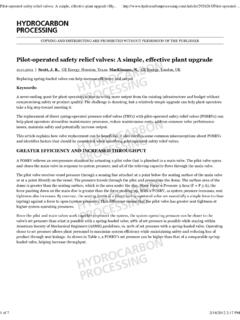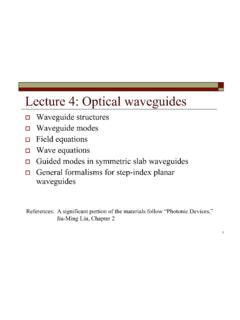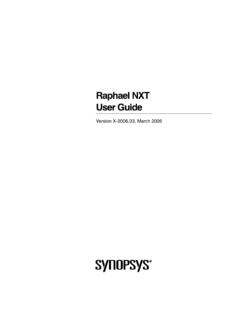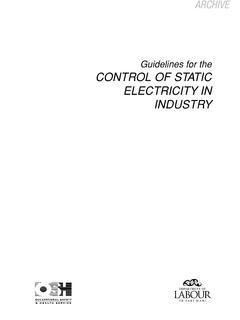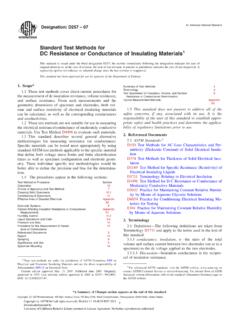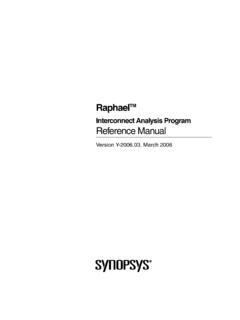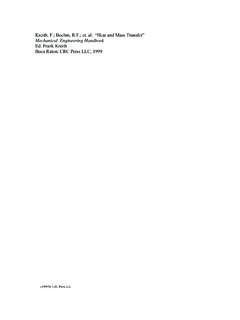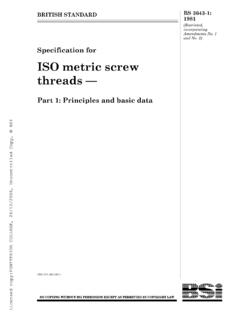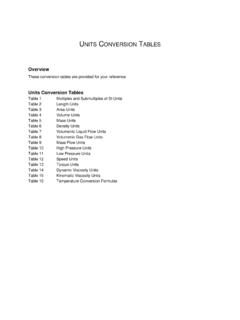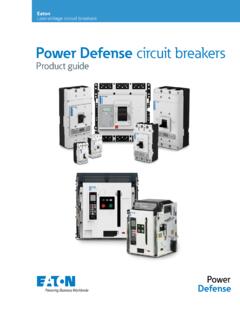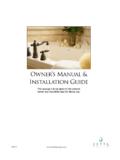Transcription of Vacuum Technology and Vacuum Design Handbook for ...
1 - 1 - ANSTO/E-775 ISBN number: 192126814X ISSN number: 10307745 Vacuum Technology and Vacuum Design Handbook for Accelerator Technicians Prepared by David Garton November 2011 Revision 0 - 2 - Vacuum Technology and Vacuum Design Handbook for Accelerator Technicians This Handbook is a compilation of information gathered from over 50 years of direct hands-on experience to applicable information widely available from the Vacuum Technology industry. It seeks to address common and specific Vacuum Technology problems whilst clarifying the Design standards and philosophies adopted for use in the ANSTO accelerator facilities.
2 The author wishes to thank the reviewers and the many technicians from ANSTO that have contributed directly and indirectly to this booklet. Revision 0 Author: David Garton, 18-11-11 Reviewer: Michael Mann, 9-12-11 Reviewer: David Button, 19-12-11 ANSTO/E-775 ISBN number: 192126814X ISSN number: 10307745- 3 - Contents Page Chapter 1 - Vacuum Design standards for the Accelerator Area 6 1. Basic Design ..6 2. Welds .. 7 3. Surface finishes .. 8 4. Flanges .. 8 5. Seals .. 9 6. Screws .. 9 7. Feedthroughs .. 9 8. Lubricants, Vacuum greases and epoxies.
3 10 9. Mounting .. 10 10. Access ..10 11. Testing .. 10 12. Operation and Continued Monitoring .. 11 Chapter 2 - Design Criteria, Information and Philosophies for Vacuum 12 1. Terminology .. 12 2. Standard Units .. 13 General Threads Pressure 3. General Design Philosophies .. 14 The Shape The size Location Mounting Flexible Design Can it be made? Safe Design Cost effective Design Design by numbers Australian Standards Environmental impact Manufacture Testing Inspection Certification Documentation Maintaining 4.
4 Performance and Operations .. 18 Ultimate Vacuum Working Vacuum Sustainable operation Operational Protocols Pump down Venting 5. Safety .. 23 General Interlocks - 4 - Fumes form exhausts Earthing 6. Serviceability .. 24 Access Maintenance Cleaning leak detection 7. Soldering wires vs mechanical joints .. 26 8. Flanges and seals .. 27 Common Vacuum seals used in the accelerator area KF Klein Flange Edwards Dependex Special Flanges ISO or LF (Large Flange) Conflat CF 9. Bellows .. 31 Corrugated style Edge Welded Bellows 10.
5 Valves .. 32 11. External Interfaces .. 33 Electrical Feedthroughs Mechanical Feedthroughs Manipulators Actuators Load locks 12. Internal Devices .. 36 Lighting Heating Cooling 13. Pumping .. 37 General High Vacuum Pumps Low Vacuum , Roughing or backing pumps 14. Monitoring .. 38 Vacuum Gauges Gauge Controllers Compound Gauges Chapter 3 - Overview of Basic Vacuum Technology 40 1. Vacuum Overview .. 40 What is Vacuum ? Units used Vacuum categories 2. Pressure Fundamentals .. 42 Ideal (General) gas equation 3.
6 Flow Fundamentals .. 43 Mean free path ( ) Mean Velocity (u) m/s Types of flow Knudsen Number (Kn) - 5 - Reynolds Number (Re) Viscous Flow Knudsen flow Molecular flow Pump throughput qpV Speed of Vacuum pump S Conductance C 4. Limitations .. 51 Contamination Condensation and vaporization Desorption, diffusion, permeation and leaks Desorption Diffusion with desorption Permeation and leaks Bake-out Residual gas spectrum Outgassing Appendices Appendix 1 Structural Calculations for Scientific Vacuum Vessel Design .
7 57 Appendix 2 Low Outgassing Specialist Non Metal Materials .. 62 Appendix 3 Materials for use in Vacuums .. 64 Appendix 4 Surface finishing .. 69 Appendix 5 Critical Vapour Pressures .. 70 o Metals o Plastics o Elastomers o Ceramics and glass o Greases and oils Appendix 6 Outgassing tables of various materials .. 72 Appendix 7 Local Plant and Safety Regulations .. 78 - 6 - Chapter 1 Vacuum Design standards and good practises for the Accelerator Area * This chapter must be read in conjunction with the detailed Vacuum information in this document.
8 * Based on best practises developed at ANSTO and other local Australian accelerator laboratories in conjunction with Australian Standards and industry technical guides, referenced throughout this document. * Where a standard is unavailable for a specific Design , best practices are used from industry s best practises. * Refers to all Vacuum chambers, beam lines and other enclosures used on the accelerators or stand alone. 1. Basic Design All Vacuum vessel designs must be consistent with the Design standards in Australian Standard AS 1210-2010 and maintain a Hazard Level of E as per the Design conditions tabled in Hazard Levels of Pressure Equipment in Section 2, Hazard Levels of Pressure Equipment in Australian Standard AS 4343-2005.
9 O The Vacuum equipment designed by/for the accelerator area maintains a Hazard level of E. All pressure equipment with a pV 30, pressure (p in MPa) x volume (litres) 30 is classed as Hazard level of E. For Vacuum equipment in Hazard Level E the de-rating value of is applied, ie 30. Note the amount of stored energy at this level is very small. For example a 1000 mm chamber, 1000 mm high will have a pV for Vacuum equal to o AS 4343-2005, Section Typical hazard levels, part (d), states for Hazard Level E, This equipment is usually exempt from special regulatory control but is covered by general plant safety regulations.
10 See Appendix 7. All designs of chambers excluding general beam lines and fittings should be checked for structural integrity using finite elements analysis. Sound designs with acceptable structural integrity will be released for manufacture. A copy of the Design acceptance tests must be filed with the project file. The standard finite element analysis can be performed utilising Solidworks. (Modelling for irregular shaped chambers, calculations Appendix 1 where appropriate for regular shapes) Stainless steel (304 or 316) will be used to construct chambers, beam lines and general fittings unless it is a special requirement to use other metals.
